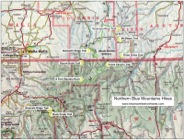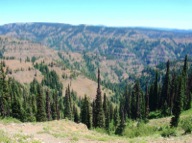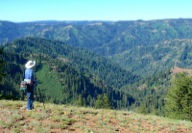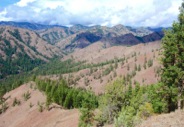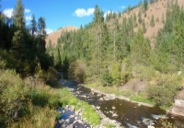Less Traveled Northwest
Day Hikes for the Adventurous
Northern Blue Mountains Hikes
The Northern Blues are "upside-down mountains." Instead of the towering, ice-sculpted granite peaks of the Southern Blues, one finds deep, steep-walled canyons eroded into flat, elevated basalt plateaus. The tops of these plateaus have most of the forest roads, the logging activity and the grazing. But the rugged, incised canyons and narrow rocky ridges between them are roadless and pristine, forming the vast Wenaha-Tucannon Wilderness and the smaller North Fork Umatilla Wilderness — the two best hiking destinations in the Northern Blue Mountains.
The most striking geologic feature of the Northern Blues is their basalts — countless horizontal bands laid down 5 to 15 million years ago in a volcanic layer cake, thousands of feet thick. Subsequent erosion exposed these layers on the sides of deep, steep-walled canyons. Also notable is the contrasting vegetation — sparse bunchgrass on the dry, south-facing slopes and thick fir and larch forests on the moister, north-facing slopes. The vegetation is also stratified by soil chemistry, where some exposed strata support healthy trees and shrubs and others are "balds," with only thin grasses. This mosaic of grassland and forest is excellent elk habitat and supports one of the densest concentrations of Rocky Mountain elk in the U.S.
Download (PDF, 334 KB): Location Map of Northern Blue Mountains Hikes
Download (PDF, 792 KB): Photos of the Northern Blue Mountains
Fortunately for day hikers, the forest roads in the Northern Blues closely surround and even penetrate into the wilderness areas, creating good access for day trips into remote spots. The easiest day hikes either follow narrow ridgelines into the wilderness, with wide views of the surrounding canyons, or they follow river courses through lush riparian forests on the canyon bottoms. More challenging and dramatic day hikes begin on the plateau rims and switchback down over 1,500' into the picturesque canyons. Developed campgrounds are found around the wilderness edges, though a few spots require dispersed camping with one's own water and sanitation. Gas and supplies are available in the surrounding towns, including Tollgate OR, Troy OR, Athena OR, Dayton WA, Pomeroy WA, and Asotin WA.
Hiking activity in the Northern Blue Mountains is less concentrated than in the Southern Blues, due to the better road access. However, popular and overused day hikes do exist, including the Oregon Butte hike in the Wenaha-Tucannon Wilderness (the highest peak in the wilderness) and the North Fork Umatilla River hike (the largest river in this wilderness). Those day hikers not compelled by the "highest and largest" will find many enticing alternative hikes, where solitude and a pure wilderness experience beckon.
Westside Wenaha-Tucannon Wilderness Hikes
With elevations up to 6,000', this is the higher side of the wilderness, with the most access roads and developed campgrounds. A few of the easier day hikes are found here as well. The 3.8-mile (one way) Sawtooth Ridge Trail starts at an easily-accessible trailhead, then follows a broad ridgeline south into the heart of the wilderness, with sweeping views over the North Fork Wenaha watershed. The 3.6-mile ridgeline trail to Round Butte can only be reached by a high-clearance vehicle, but is arguably the most scenic ridge hike in the wilderness and is prime summer habitat for elk. The easily-accessible Tucannon River Trail follows the north side of the river for 4 miles through primeval fir forests to its confluence with Bear Creek.
> Sawtooth Ridge Trail
> Round Butte Trail
> Tucannon River Trail
Eastside Wenaha-Tucannon Wilderness Hikes
With trailhead elevations around 4,000', this is the lower and more remote side of the wilderness, with fewer developed campgrounds — so dispersed camping is required in a few areas. But it offers a few of the most dramatic and challenging day hikes in the wilderness. The gentle 3.2-mile trail into the South Fork Wenaha basin is perhaps the finest forest hike here, through groves of pristine grand fir. The strenuous Cross Canyon Trail switchbacks down 1,750' in 2.8 miles into the scenic Wenaha River canyon, with the potential for Shiras moose sightings at the bottom. The equally demanding Three Forks Trail descends 1,600' in 3.2 miles into the picturesque Crooked Creek canyon. Finally, the higher-elevation Mt. Misery Trail traverses a 6,000'-high rim for 4 miles, with panoramic wilderness vistas throughout, plus a side visit to scenic Diamond Peak.
> South Fork Wenaha River Trail
> Cross Canyon Trail
> Three Forks Trail
> Mount Misery Trail
North Fork Umatilla Wilderness Hikes
At just over 30 square miles, this smaller of the two wilderness areas is also the lowest, with elevations from 2,200' to 4,600'. But it's nearly identical to its larger sibling, with layers of basalt incised by deep stream canyons and dry, grassy hillsides next to moister, forested slopes. A good access road leads to a campground and several nice dispersed campsites at riverside along the wilderness boundary. The best view hike is the Ninemile Ridge Trail, which gradually switchbacks up over 1,200' in 2.3 miles to sweeping wilderness vistas, then ascends the spine of the ridge to even higher viewpoints. A pleasant, less-traveled creek hike follows the Buck Creek Trail for 3.6 miles through pristine riparian forests of tall cottonwood and fir to a shady streamside camp.
> Ninemile Ridge Trail
> Buck Creek Trail
Clickable map of Northern Blue Mountains hikes:
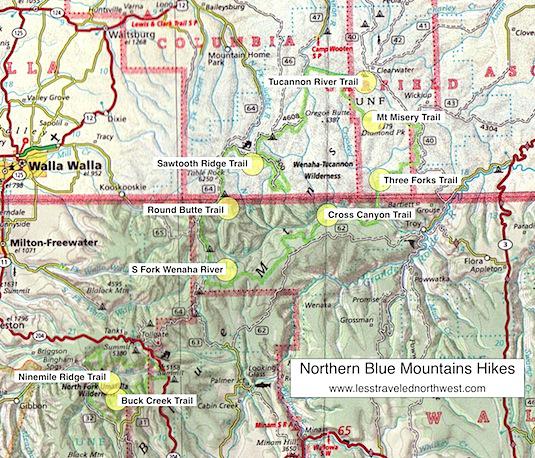
Page last updated: 11/17/13

